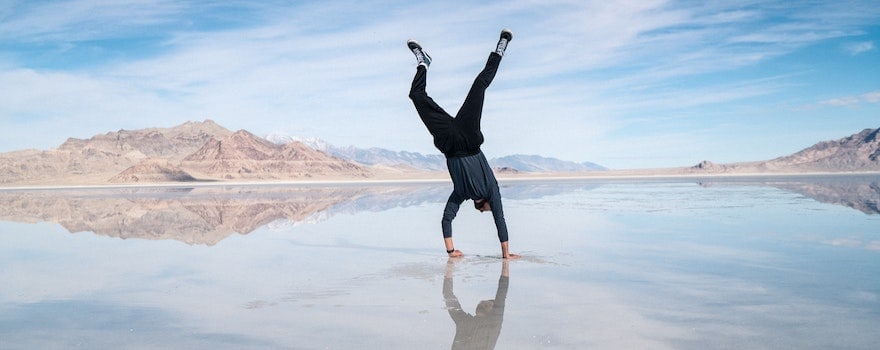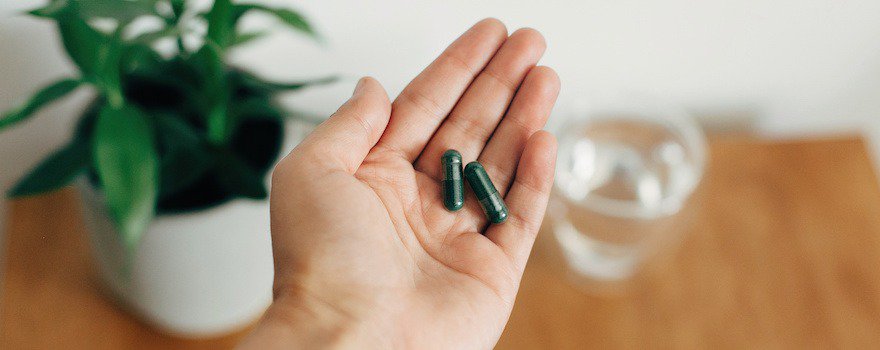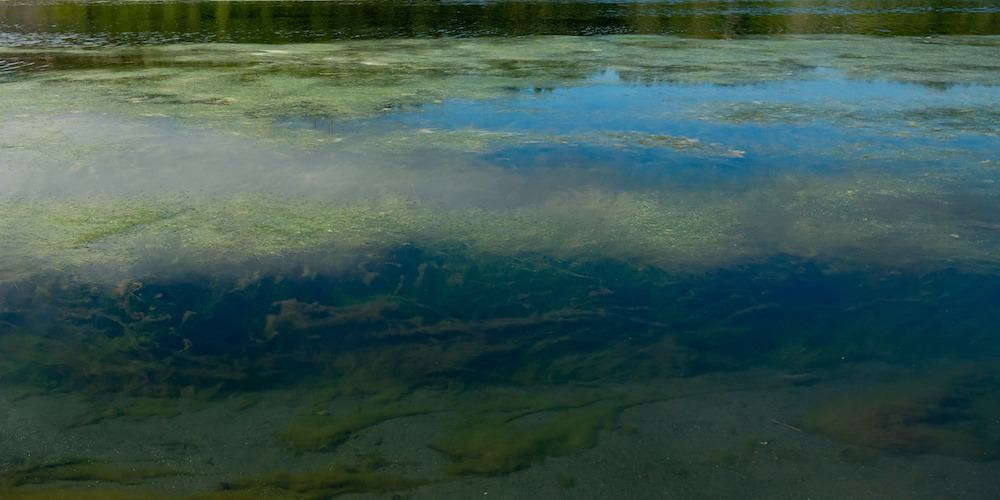What is Klamath?
Like spirulina (Arthrospira platensis) or chlorella (Chlorella vulgaris), Klamath is not an algae in the true sense but a cyanobacterium (also called “micro-algae” or “blue-green algae”). This branch of bacteria differentiates itself by its ability to perform photosynthesis and its chlorophyll content.
Klamath, scientifically known as Aphanizomenon flos-aquae, is a micro-algae native to Upper Klamath Lake located in Oregon, in the northwestern United States. It thrives abundantly there because it finds in these fresh, pure, and unspoiled waters all the conditions necessary for its growth.
Klamath is a filamentous cyanobacterium that develops on the water’s surface and resembles a blade of grass. Its blue-green color is due to the presence of chlorophyll and pigments like phycocyanins.
Although devoid of a nucleus, Klamath is equipped with very efficient cells, called heterocysts, which allow it to perform photosynthesis by fixing atmospheric nitrogen. It also possesses akinetes, resistance cells that take over when conditions are unfavorable: cold, low light, lack of nutrients…

Although its traditional use is not precisely known, it is believed to have been consumed for a long time by the Klamath tribe, a Native American people from Oregon. It was only from the 1990s that its consumption began to spread. The annual production from Klamath Lake then reached more than a ton. Numerous scientific studies have subsequently contributed to its popularity worldwide.
It contains no less than 20 amino acids and 14 vitamins, not to mention the minerals, trace elements, and natural substances it contains.
Today, Klamath is primarily consumed as a dietary supplement, in capsules, tablets, flakes, or powder. Its exceptional composition makes it a very interesting superfood for regenerating the body, stimulating immunosurveillance (the process that allows the immune system to control pathogenic cells), preventing deficiencies, and relieving depression.
Nutritional Composition
- 20 amino acids including 10 essential ones: arginine, histidine, isoleucine, leucine, lysine, methionine, phenylalanine, threonine, tryptophan, valine
- 14 vitamins: A, C, E, B1, B2, B3, B6, B8, B12, K…
- Minerals and trace elements: calcium, copper, potassium, zinc, magnesium, iron, germanium, selenium…
- Phenylethylamine
- Proteins
- Antioxidant pigments: phycocyanin, beta-carotene and carotenoids
- Unsaturated fatty acids: omega 3, omega 6
- Chlorophyll
- Polyphenols
- Polysaccharides
- Peptides
- Lipids

The Benefits of Klamath
🛡 Activates Immunosurveillance
Klamath does not directly stimulate lymphocytes (white blood cells) but activates immunosurveillance. Immune surveillance is a natural physiological function that allows the continuous monitoring and recognition of pathogens. It is through this upfront immunosurveillance that immune defenses are activated.
This property is due to phycocyanin, an immunomodulatory pigment found in this micro-algae and also present in spirulina. Additionally, other compounds of the micro-algae contribute to the proper functioning of the immune system: iron, selenium, zinc, vitamin C…
This study by McGill University in Montreal, conducted on volunteers, shows the positive effects of Klamath consumption on the immune system.
🧘🏽♀️ Relieves Depression and Contributes to Mental Well-being
Klamath does not only act on the physical: it is also an interesting superfood for improving mental well-being. Its consumption is recommended in cases of depression or temporary blues, mental fatigue, concentration difficulties…
The microalgae contain valuable compounds known for their action on the nervous system. It notably presents a significant amount of vitamin B12 (4-6 mcg/g of which at least 1 mcg/g is assimilable) and tryptophan (15 mg/g).
Vitamin B12 helps, among other things, to reduce mood disorders. A B12 deficiency can indeed lead to a depressive state. Tryptophan, on the other hand, directly contributes to the formation of serotonin, also known as the “happiness hormone”.
Finally, klamath contains phenylethylamine (PEA), a substance naturally produced by the body. Also known as the “love molecule,” it produces an intense sensation of well-being. Phenylethylamine has also proven effective in treating behavioral disorders.
This study by various Italian universities, conducted on patients suffering from attention deficit/hyperactivity disorder (ADHD), shows the potential of phenylethylamine contained in klamath to improve the symptoms of the disease (inattention, impulsivity…).
🥝 Fights Free Radicals
Klamath is a food with antioxidant action. Its content of beta-carotene, phycocyanin, polyphenols, and vitamin C allows it to effectively fight free radicals. Thus, its consumption prevents oxidative damage to cells.
The microalgae act effectively against oxidative stress caused by excess free radicals in the body. It is notably involved in the onset of age-related diseases and aging such as Alzheimer’s disease.
This study from the National Scientific Research Center of Havana in Cuba, conducted on mice, demonstrates the trapping action and antioxidant properties of blue-green algae phycocyanin on free radicals.
This other study from the University of Palermo in Italy, conducted directly on bioactive molecules, focused on the potential of klamath in preventing oxidative stress.
🍽 Prevents Deficiencies
Klamath is considered one of the most nutritious superfoods in the world. Indeed, it is rare to find so many assimilable nutrients in one single food. By themselves, amino acids represent more than 50% of the weight of klamath.
The consumption of klamath is particularly recommended for vegetarian or vegan individuals to prevent deficiencies in iron, vitamin B12 (but in amounts too low to completely avoid supplementation) and omega 3 and 6. It also allows for a good intake of plant proteins.
This study from the Institute of Biomedicine and Molecular Immunology of Palermo in Italy, conducted directly on cells, provides more insight into the composition of klamath.
♾ Promotes Stem Cell Production
Klamath has the particularity of stimulating the production of our own stem cells. These cells are actually the “mother cells” of all the organs and tissues of the human body. They are responsible for their formation as well as for the production of “sub-cells” in each organ and tissue. Stem cells are also capable of repairing damaged organs or tissues.
Within the body, stem cells multiply indefinitely. However, age, free radicals, diseases, etc., reduce their proliferation and restoration capability. By promoting stem cell production, klamath supports the regeneration of organs and tissues.
This study from the University of South Florida in the United States, conducted on human cells, studied the action of klamath on stem cell proliferation.

How to Consume Klamath?
Klamath Tablets
Klamath tablets or capsules constitute the simplest form to take and the easiest to find on the market. This type of dietary supplement also has the advantage of being tasteless. Indeed, klamath has a strong odor and a pronounced algae flavor that may not appeal to everyone…
Preferably choose capsules containing 100% natural klamath and/or certified organic, without GMOs, additives, and preservatives.

Klamath flakes
Klamath can be found in flakes, which is dehydrated algae. This form is quite natural and minimally processed, retaining its nutritional richness well. As with capsules, ensure you check the composition and prefer klamath from organic farming.
If you enjoy its algae taste, you can sprinkle flakes directly on foods (salads, soups, compotes…) or in a liquid such as a green smoothie, for example.
Klamath powder
Klamath powder is quite easy to find in organic and specialized stores or online. After harvesting, the microalgae is dried and then ground into powder. Choosing this format is a good way to benefit from its nutritional virtues.
Klamath powder is used in the same way as flakes: sprinkled on savory or sweet dishes, mixed with water, fruit juice, or a smoothie…

Fresh klamath
Only the United States commercializes fresh klamath. This refers to klamath that is directly frozen right after harvesting. The freezing process helps preserve the nutritional quality of the microalgae.
Klamath and Spirulina
It’s not uncommon to find dietary supplements combining klamath and spirulina. Indeed, these two microalgae work synergistically to boost natural defenses, provide energy and vitality to the body. The klamath/spirulina combination is ideal for athletes, fatigued individuals, students, and older adults.
To stimulate the body, it can also be consumed with certain medicinal plants like maca (Lepidium Meyenii), tribulus (Tribulus terrestris), or guarana (Paullinia cupana).
Criteria to consider
When choosing your klamath, it’s important to consider the 3 main criteria:
- Certifications,
- Drying method,
- Country of origin.
Regarding certifications, choose a dietary supplement labeled “AB/Euroleaf” and certified by “Organic Tilth Certified Oregon” (OTCO). This label, issued by Oregon Tilth, guarantees klamath cultivated in organic agriculture.
Also ensure that the algae was cold air-dried, a method that preserves nutrients unlike warm air drying.
Finally, klamath must come from the United States and be harvested wild in Klamath Lake.
Klamath dosage
⚖️ Although there is no specific recommended dosage for klamath, it’s advised not to consume more than 3 grams per day.
⏳ Consumption should preferably be spread out into 2 doses, in the morning and at noon, before meals. Due to its tonic effect, avoid consuming it late in the day.
⏳ Klamath can be taken daily or in the form of 3 to 6-month courses with a break every 3 weeks.
💊 In tablets: up to 6 per day for 300 mg capsules.
🥗 In flakes: 1 level teaspoon per day.
🥄 In powder: 1 level teaspoon per day.
Contraindications and side effects
The consumption of klamath has certain contraindications and is not recommended for the following people:
- As a precautionary measure, young children, pregnant or breastfeeding women should avoid klamath.
- Due to its vitamin K content (involved in blood clotting), it is not recommended for people on anticoagulant therapy.
- Klamath, which is rich in iodine, should be consumed cautiously by individuals with cardiac history, renal insufficiency, or thyroid disorders.
Taking klamath can cause the following side effects:
- Migraines.
- Digestive disorders (stomach pains, diarrhea).
- Nausea.
If symptoms persist, stop consumption and consult a doctor.
History, culture, and market of klamath
A preserved environment
Klamath grows in an exceptional environment. Indeed, Klamath Lake constitutes a vast expanse of freshwater covering 250 km². It is a high-altitude lake particularly rich in nutrients and protected from industrial pollution. The purity of its water is due to Klamath Lake being fed by 17 springs and receiving water from the melting snow of the surrounding volcanic mountains.
But fragile
Unfortunately, climate change and the increase in droughts undermine this balance. The growing demand for Klamath microalgae also burdens the preservation of the lake. Fortunately, its harvesting is still artisanal and very limited. The microalgae can also reproduce very quickly during the summer.
From June to October, Klamath is harvested from barges equipped with a selective system to avoid collecting other microalgae in the lake. Other gatherers, however, use the pumping technique that allows them to harvest up to 1.6 kg of microalgae per second! A much less respectful harvesting method…
Currently, some scientists are trying to cultivate Klamath in a laboratory with the aim of making it more accessible and meeting the challenge of feeding 10 billion humans by 2050.
Report by Julia Perez and Charlotte Jean
Sources and scientific studies
Wayne Carmichael, Christian J Drapeau, Donald M Anderson, 2000. Harvesting of Aphanizomenon flos-aquae Ralfs ex Born. & Flah. Var. flos-aquae (Cyanobacteria) from Klamath Lake for human dietary use.
Gitte Jensen, Donald I. Ginsberg, Patricia Huerta, Monica Citton, Christian J Drapeau, 2000. Consumption of Aphanizomenon flos-aquae Has Rapid Effects on the Circulation and Function of Immune Cells in Humans A novel approach to nutritional mobilization of the immune system.
Cremonte M, Sisti D, Maraucci I, Giribone S, Colombo E, Rocchi MBL, Scoglio S, 2017. The Effect of Experimental Supplementation with the Klamath Algae Extract Klamin on Attention-Deficit/Hyperactivity Disorder.
Romay C, Armesto J, Remirez D, González R, Ledon N, García I, 1998. Antioxidant and anti-inflammatory properties of C-phycocyanin from blue-green algae.
Nuzzo D, Contardi M, Kossyvaki D, Picone P, Cristaldi L, Galizzi G, Bosco G, Scoglio S, Athanassiou A, Di Carlo M, 2019. Heat-Resistant Aphanizomenon flos-aquae (AFA) Extract (Klamin®) as a Functional Ingredient in Food Strategy for Prevention of Oxidative Stress.
D. Nuzzo, G. Presti, P. Picone, G. Galizzi, E. Gulotta, S. Giuliano, C. Mannino, V. Gambino, S. Scoglio, et M. Di Carlo, 2018. Effects of the Aphanizomenon flos-aquae Extract (Klamin®) on a Neurodegeneration Cellular Model.
Roland Shytle, Jun Tan, Jared Ehrhart, Adam J Smith, Cyndy D Sanberg, Paul Sanberg, Jerry Anderson, Paula C Bickford, 2010. Effects of blue-green algae extracts on the proliferation of human adult stem cells in vitro: A preliminary study.



